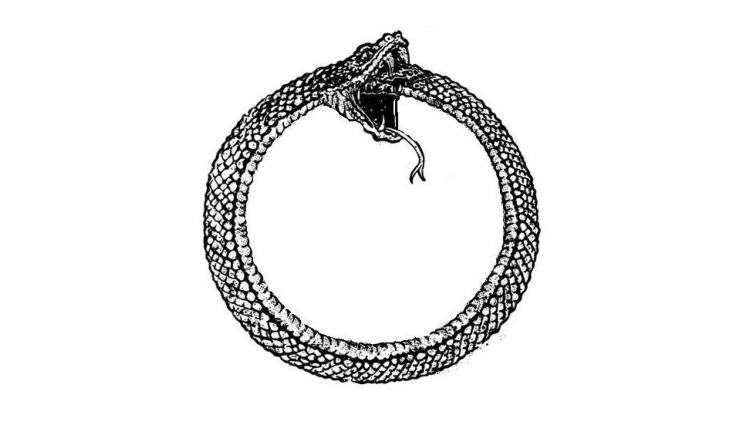Russell's Paradox

Ouroboros, 'tail-devourer', symbolises infinity, the cycle of life and death. But we deploy the image here to convey a paradox: of defining things with reference to themselves.
Paradoxes are logically self-contradictory statements. Russell’s paradox or the Russell-Zermelo paradox—named after Bertrand Russell and Ernst Zermelo (but first published by the former)—is one of the best-known.
Russell’s paradox offers a challenge to set theory, the branch of mathematical logic for grouping objects together. ‘Set theory’ may read unfamiliar. But most of us know the basics from Venn diagrams: each circle encloses a set of similar objects—the elements—which are related across groups where the circles intersect. These elements can be mathematical (e.g. numbers) or ordinary (e.g. musical artists).
But Russell’s paradox exposes a problem.
Let’s group together all the sets—all the circles in a Venn diagram—that do not contain themselves as elements. We’ll call this set of sets R.
Sets that do contain themselves are like serpents consuming their own tails: the serpent is the set; its stomach is a subset. We often want to avoid these in our definitions since they represent something circular and absurd.
But, wait, what about R, the serpent, itself? Is R a member of R? For R is a set, too. Here’s the paradox.
R is a member of R if and only if R is not a member of itself, as per our definition of sets in R. But, ahhh! We have contradiction. For R belongs to itself because it doesn’t belong to itself.
The issue arises because of self-referencing.
Take a shoeshine boy who only shines the shoes of people who don’t shine their own shoes. Does he shine his own shoes? If yes, he’s not a shoeshine boy by definition; if no, his shoes must be cleaned by the shoeshine boy, himself—a contradiction either way.
A resolution was reached in 1908 by Zermelo, who introduced some axioms to clear up the mess. Others did the same.
Now go and enjoy some good Venn diagrams! It won’t be in vain.
To finish, here’s another paradox of self-reference (hungry serpent).
If you choose an answer to this question at random, what’s the chance it’ll be correct?
- 25 %
- 0 %
- 50 %
- 25 %
